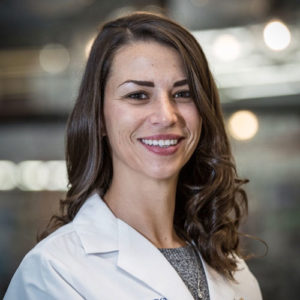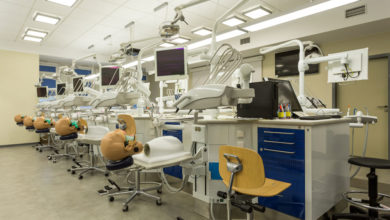Is an MD/PhD Program Right for You?
MD-PhD programs may be right for you if you are interested in a career path that melds both clinical practice and in-depth scientific research. MD-PhD graduates aren’t simply doctors; they are “physician-scientists” or “medical scientists.”
MD-PhD programs offer a dual-degree track that combines the clinical training of a standard MD degree with the added coursework of a PhD. The PhD training is particularly rigorous and includes classes usually in the realm of biomedical sciences, as well as advanced research training, lab rotations, and intensive investigative work.
The payoff for choosing an MD-PhD program is that these clinical medicine graduates are equipped to treat patients while also participating in the discovery and development of innovative healthcare solutions.
Here are a few reasons you might want to pursue an MD/PhD career:
- You want to participate in cutting-edge medical research.
- You want career options beyond clinical medical practice.
- You want to help train future generations of medical doctors.
- You want more collaborative research opportunities with colleagues.
- You want funding opportunities only available to MD/PhD students.

The Difference Between MD & MD/PhD
The difference between MD and MD-PhD is that graduates with an MD-PhD receive PhD training and hold a PhD degree in addition to their MD degree.
The cost of an MD-PhD program varies widely depending on the institution. Still, the stipend and tuition-free training make many of these programs significantly less financially burdensome compared to standalone MD or PhD programs.
MD/PhD students will complete graduate school and medical school qualified to hold positions in academic medicine and biomedical research (in addition to being qualified to practice clinical medicine.
What Is an MD?
A medical doctor has earned a standard medical degree or MD and is skilled to practice clinical medicine. Medical students must complete 4 years of medical school to earn their degree, followed by 3-7 years of residency and fellowship training to practice medicine.
What Is a PhD?
PhD stands for Doctor of Philosophy in reference to their critical knowledge and research experience in a particular field of study. A PhD is the highest possible academic degree.
Earning a PhD is often considered harder than earning an MD due to the scientific research required to stimulate original thought and develop quality hypotheses.
How Competitive Are MD/PhD Programs?
Physician-scientist programs are slightly more selective and competitive than the average medical program.
Between 2018 and 2023, a little more than one-third of students who applied to an MD/PhD program (37.7%) were accepted. The acceptance rate for medical school applicants in general was 41.2% for the 2022-23 application cycle.
The test scores of these programs also indicate how much more competitive these programs are. The average MCAT score of MD/PhD matriculants in the 2022-23 cycle was 516.2, and their mean GPA was 3.82. In comparison, medical school matriculants overall had an average MCAT score of 511.9 and average GPA of 3.75 during the same cycle.
How Long Are MD/PhD Programs?
The MD-PhD dual degree takes approximately 7-8 years of coursework to complete, followed by an additional 3-7 years of residency to be eligible to practice medicine.
Generally, MD coursework is emphasized in years 1-2, followed by research training in years 3-5, and ending with medical training and clinicals in years 6-8.
Requirements for MD/PhD Applicants
If you are considering applying to an MD/PhD program , know that having strong essays and letters is more important than incrementally higher MCAT test scores and GPAs. Numbers get your foot in the door; storytelling gets you a seat at the table.
In general, the requirements for MD/PhD applicants include:
- MCAT score in the 90th percentile: Specific MCAT requirements for MD/PhD programs vary by school. However, in general, most students have the best chance at success with an MCAT score in the 90th percentile or higher. In the 2022-23 application cycle, MD/PhD applicants had an average MCAT score of 511.3, while matriculants averaged 516.2.
- GPA of 3.7 or higher: Like MCAT scores, the GPA requirements for MD/PhD programs differ by program. But your chances are highest with an average GPA of at least 3.7. In the 2022-23 application cycle, MD/PhD applicants averaged a science GPA of 3.61 and overall GPA of 3.68, while matriculants averaged a 3.78 science GPA and 3.82 overall.
- Compelling personal statement: Your personal statement essay should explain why you want to become a physician and is required for both MD & MD/PhD applications . All prospective doctors must write a personal statement that stands out, and this is doubly true for MD/PhD applicants.
- 2 additional essays: You’ll write one essay conveying your personal interest in pursuing an MD/PhD dual degree specifically, and one essay covering your substantive experiences in the field of research . These may include multiple summer projects, senior thesis research, or 1+ years of post-undergrad research programs and activities.
- 2-3 letters from research mentors who can praise your scientific potential.
- 1-2 letters from clinical mentors who know your aptitude for patient care.
- 1 letter from the premed committee.
- 1 letter from a mentor who can discuss your leadership skills and personal traits in an extracurricular setting.
Questions to Ask Yourself When Considering an MD/PhD Program
By answering these questions, you can choose the graduate program that is the best fit for you over the next 8 years.
- What skills do you want to develop? Choose a program that has ample opportunities to explore your field of interest and in which you can identify potential mentors for rotations and thesis projects.
- What is your preferred MD/PhD program size? Choose a smaller program of MD-PhD students if you prefer hands-on guidance with individualized attention and a larger program if you prefer a larger community with more networking opportunities.
- Where do you want to live for 8 years of medical school ? Choose a location that fits your needs for cost of living, housing, transportation, extracurriculars, as well as opportunities for fun and making friends.
- Does the program offer financial aid? Choose a program that meets your financial needs in the form of stipends and tuition waivers. It’s important to note that if you drop out of an MD-PhD program, some schools require you to pay back the investment that the school made in you.
- Will you fit into the school’s culture? Choose a program after you’ve visited the campus, talked with the current students and faculty, and asked about opportunities in your field of interest as well as other’s experiences at the school and living in the city.
- Does the MD/PhD Program align with your timeline? Choose a program with coursework that allows you to graduate in your preferred timeline, which could be sooner or longer than eight years.
Possible Career Paths for MD/PhD Graduates
A career choice often depends on an individual’s specific interests, such as which medical specialties they are drawn to, whether they prefer working with patients or in a laboratory, and how they want to contribute to advancing medical science.
The salary range for MD/PhD graduates varies significantly by position and type of work. Policy analysts’ starting salary is around $57,000 per year, while attending physicians who do research can make upwards of $500,000.
Below are careers someone with an MD-PhD might pursue:
Attending Physician with Research Responsibilities
An MD/PhD holder in this position would have a traditional medical role seeing and treating patients, but they might also have dedicated time for research. This role allows one to continue practicing medicine while contributing to academic or clinical research.
Individuals in this role often split their time among patient care, research activities, and instructional duties. Typically, they are found in educational hospitals or medical schools.
Physicians’ salaries can vary significantly based on specialty and experience, but generally, they are well-compensated. An attending physician in a specialized field can expect to earn upwards of $200,000 to $500,000 or more, especially if they have dual responsibilities that include research.
Translational Medicine Specialist
These specialists work at the intersection of basic research and patient care, focusing on turning research insights into practical medical applications.
This role may exist within academia, industry, or clinical settings and is tailored for those who understand both the clinical and research aspects of medicine.
The salary for this role can also vary based on industry, location, and level of experience but would likely fall in the range of $150,000 to $250,000 or more.
Biomedical Researcher
Those with MD-PhD qualifications commonly secure jobs as researchers within biomedical science. Employment settings can range from academic institutions and drug companies to governmental agencies like the NIH.
Salaries for biomedical researchers typically fall somewhere between $85,000 and $104,000 per year.
Clinical Research Director
These are medical doctors responsible for overseeing clinical trials and research projects, usually within a hospital, academic institution, or pharmaceutical/biotech company. This role leverages both the clinical insights from an MD and the research methodology of a PhD.
Salaries can vary widely depending on the setting (academia, private industry, etc.) and geographic location. In general, a Clinical Research Director could expect to earn a six-figure salary, often ranging from around $150,000 to $250,000 or more per year.
Pharmaceutical/Biotech Industry Professional
A significant number of MD-PhDs join the pharmaceutical or biotech sectors. Responsibilities might include roles in the development of new medications, overseeing clinical trials, regulatory compliance, or managing medical affairs.
The average salary for this position will likely differ quite a bit depending on the exact role and company, but the average is generally between $125,000 and $133,00 per year.
Medical Director
In this capacity, a person is in charge of the medical elements of a healthcare facility or a specific department within a hospital. The role usually calls for expertise in both medical practice and research.
This position is likely to be one of the most lucrative of the MD/PhD field, with an average salary from $319,000 to $329,000 per year.
Science Policy Analyst/Advisor
Individuals in this role often find themselves in governmental or nonprofit settings, where they influence policy decisions related to scientific research and healthcare.
The typical salary for a science policy analyst starts at around $57,000 per year. Advisors have a slightly higher upper salary range and may make as much as $75,000.

Public Health Official
Some MD-PhDs opt for roles in the public sector where they focus on health concerns at a societal level. They may be employed by organizations such as the CDC or WHO.
In many cases, public health officials can expect to make a yearly salary of between $101,000 and $111,000.
Medical Science Liaison
This role typically serves as an intermediary between pharmaceutical enterprises and medical professionals. These liaisons disseminate information about new treatments and scientific advancements to doctors, researchers, and other medical stakeholders.
This role also typically commands a six-figure salary, usually ranging from approximately $100,000 to $200,000, depending on experience, location, and the hiring organization.
Medical Educator
Professors teach medical students, residents, and fellows in an academic setting while also conducting research. These doctors often have clinical responsibilities as well. An MD/PhD is especially well-suited for this role due to the dual focus on clinical care and research.
They may teach various medical subjects like pharmacology or genetics and actively participate in the educational goals of their institutions.
In academia, salaries can vary widely based on rank (Assistant Professor, Associate Professor, Full Professor), institution, and geographic location. Salaries may range from $100,000 to well over $200,000 for senior roles or those at prestigious institutions.
Best MD/PhD Programs in the US
There are 122 different American Universities that offer MD/PhD degree programs, according to the AAMC list of MD-PhD Programs by State . A further 13 Canadian programs also use the AMCAS application system.
Some MD-PhD programs in the United States are funded by the National Institutes of Health (NIH) through the Medical Scientist Training Program (MSTP). This means that students receive full tuition remission, health insurance, and a living stipend throughout their training.
Medical schools with fully funded MD-PhD programs :
- Dartmouth University, Geisel School of Medicine
- Duke University School of Medicine
- Harvard/M.I.T MD-PhD Program, Harvard Medical School
- John Hopkins University School of Medicine
- Mayo Clinic College of Medicine & Science
- University of Florida College of Medicine
- University of Pennsylvania, Perelman School of Medicine
- University of Southern California (USC), Keck School of Medicine
- Yale University School of Medicine
Medical schools with the most MD-PhD spots historically:
- Raymond and Ruth Perelman School of Medicine at the University of Pennsylvania
- University of Illinois College of Medicine
- Weill Cornell Medical College
- Washington University in St. Louis School of Medicine
- Johns Hopkins University School of Medicine
- Albert Einstein College of Medicine of Yeshiva University
- University of California, Los Angeles David Geffen School of Medicine
- University of Michigan Medical School
- Columbia University College of Physicians and Surgeons
- University of Pittsburgh School of Medicine
- Harvard Medical School
- Case Western Reserve University School of Medicine
- Northwestern University The Feinberg School of Medicine
- Icahn School of Medicine at Mount Sinai
- University of California, San Francisco, School of Medicine
- Vanderbilt University School of Medicine
- Ohio State University College of Medicine
- University of Wisconsin School of Medicine and Public Health
- New York University School of Medicine
- Stanford University School of Medicine
- Yale School of Medicine
Medical schools with MD/PhD programs that accept international students:
- Emory University School of Medicine
- Northwestern Feinberg School of Medicine
- University of Pennsylvania Perelman School of Medicine
- University of Southern California Keck School of Medicine/California Institute of Technology
- University of Texas Southwestern Medical School
- Washington University School of Medicine in St. Louis
The MD/PhD Application Process
The application process for MD-PhD programs is similar to that of typical MD programs. The two major differences are that you’ll designate yourself as an MD/PhD candidate on the AMCAS application, and you’ll submit 2 additional essays on that primary.
The Application Timeline
- AMCAS (submit by end of May): You’ll fill out a primary application through AMCAS in the spring of the first year of your application cycle (e.g., to matriculate in fall 2026, you’ll submit AMCAS in spring 2025). AMCAS opens at the end of May each year. Aim to submit the primary application no later than the end of June, as early applications are more likely to be reviewed and accepted.
- Secondaries (submit by end of August): You’ll respond to secondary applications in the summer after your primary application is reviewed by each school you submitted it to. Each program sends secondary applications to students who generally meet their minimum requirements.
- Interviews (October-March): You’ll then attend interviews as invited between October and March. Some schools won’t contact you at all to reject your application; others will offer conflicting invites. You must prioritize your options and prepare for the opportunities that do come.
- Final decisions (December-March): Final decisions are made by schools between December and March. Schools with a rolling admissions cycle (most of them) accept students after completing interviews and determining a student is a fit. A smaller number of programs wait to send acceptances until after all interviews are complete.
- Choose your program (March-April): Students choose where to matriculate between March and April.
- Programs start (June-August): Programs begin between June and August, depending on the school.
How to Prepare for an MD/PhD interview
You should prepare for your MD/PhD interview by practicing mock interviews to rid yourself of the jitters and fine-tune your responses in various scenarios. In addition to developing your personal narrative, you must be able to explain your research training at multiple levels.
If you’re interested in participating in a mock interview with a physician who has served on an admissions committee, consider a mock interview with MedSchoolCoach .
What to Do if You Get Waitlisted
Finding out that you’ve been waitlisted for the MD/PhD program of your dreams is never a good feeling. However, you are not helpless in the wait. It’s a good idea to remain in contact with program leaders and administrators by sending a Letter of Intent or a Letter of Interest.
Listen: An MD/PHD’s Journey to Medicine [PODCAST]
What is a Letter of Intent vs. a Letter of Interest?
A Letter of Intent is a formal statement that you would commit to matriculating into a program if you are accepted. A Letter of Interest conveys that you are strongly interested in the program, but it does not indicate any commitment or explicitly state that a program is your first choice.
Both letters should summarize why you believe the program and school are a great fit for your interests and how you will be able to uniquely contribute to the school, in under one page.
Finding Out You’ve Been Accepted!
The day you receive that phone call or email — the one from the MD-PhD program director contacting you to say you have officially been offered acceptance into their program — provides a feeling of joy worth being patient for!
Our Physician Advisors can support you through the application process for your best shot at getting into the school of your choice.
What specialties can MD/PhD graduates earn their PhD in?
PhD students commonly choose to specialize in topics such as:
- Cell Biology
- Biochemistry
- Pharmacology
- Neuroscience
- Biomedical Engineering
What is the salary range for an MD/PhD graduate?
MD/PhD graduates can expect an average annual salary of about $100K, depending on the type of work and place of employment.
What is the difference between a PhD and a Postdoctorate?
A Postdoctoral Fellowship is a temporary period of mentorship and research training for graduates with doctoral degrees, offered by the National Institutes of Health, to acquire skills needed for a chosen career. A PhD thesis must be successfully defended, whereas a postdoc is a non-defendable temporary employment assignment from an organization such as a university.
Can an MD/PhD be a doctor?
Graduates who earn an MD/PhD are fully qualified doctors and may practice medicine in a clinical setting upon completing their residency training.
Can an MD/PhD graduate be a surgeon?
While an MD/PhD graduate CAN be a surgeon if they choose surgery specialties in their residency programs, a surgical resident is not required to obtain a PhD in addition to their MD.
Schedule a free 15-minute consultation with MedSchoolCoach to learn how we can help boost your chances of success getting into medical school .
Related posts:
- How to Write About COVID-19 in Your Medical School Personal Statement
- Use MSAR To Choose Which Medical Schools You’ll Apply To
- 5 Reasons to Consider a Pre-Med Traveling doctor program(+ Tips for Traveling!)
- What Counts as Clinical Experience for Medical School?

Renee Marinelli MD
Related articles.

What Questions to Ask Your Student Interviewers for Medical School

Why Medicine Needs Diversity

10 Most Popular Medical Schools

How to Get into Med School When You’re Not Pre-Med

IMAGES
VIDEO